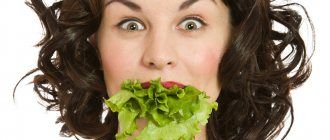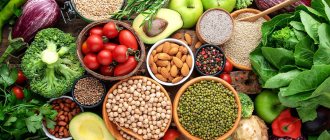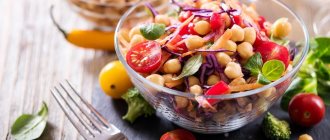By blood
There are quite a few types of diets today, most of them combine two key requirements - limiting the amount of food a person consumes per day and focusing on a certain set of foods.
Eat and get slimmer: nutritionists name foods that help you lose weight
Many of them will help not only get rid of excess weight, but also improve your diet.
At the same time, simply giving up junk food - for example, fatty, sweet or fried foods, without reducing portions - will certainly have a positive effect on the condition of the body and even, possibly, lead to minor weight loss. But it’s unlikely to help you lose weight.
The diet and meal schedule depend on the chosen diet. Some experts, among other things, recommend focusing on the characteristics of the body inherent in us by nature.
Thus, the diet of American Peter D'Adamo is based on the assumption that people with different blood types need different foods.
According to the scientist, people with the first blood group (it is the most common, about 40% of the world's population have it) are closer to a meat diet, which requires the presence of protein. Eating fish and poultry with limited carbohydrates, grains and legumes is also suitable.
Blood type, genotype and daily routine
Photo: Depositphotos/timolina
They're crazy about fat: what diets do Russians most often search for on the Internet?
Not all weight loss methods work as advertised
“The author calls people with the second blood group farmers. Its owners are approximately 39% of the world's population. Accordingly, their diet should be dominated by vegetables, fruits, legumes, and gluten-free grains. But meat, dairy and fermented milk products, coffee and alcohol should be limited,” Ulyana Rumyantseva, candidate of medical sciences, endocrinologist, nutritionist at SM-Clinic, told Izvestia.
People with the third blood group in this system are considered nomads - this is approximately 15% of the world's population. Experts recommend that they eat mainly vegetables, fruits, dairy and fermented milk products, and any meat except chicken. It is recommended to exclude seafood and products made from wheat flour.
The fourth blood group is the smallest. It is present in approximately 6% of the population and, according to Peter D'Adamo, has inherited the features of the second and third groups. Such people, according to the author of the theory, can eat almost anything. It is suggested to exclude beef (and red meat in general), corn, beans and alcoholic beverages. And fish, any meat except red, dairy and fermented milk products, legumes, grains, vegetables and fruits can be especially suitable for them.
Diet for blood group 4 “Mixed type”
The author of the diet classifies representatives of blood group 4 as mixed type. There are no more than 8% of such people in the world. They have low immunity and a weak digestive system. A mixed diet of “nomads” and “hunters” is suitable for such people.
Characteristics of people of “mixed type”:
- The immune system, although very flexible, is at the same time susceptible to various infections. The strengths of both “nomads” and “hunters” are present.
- The digestive system is quite weak.
- There are risks of developing diseases such as anemia, oncology, and heart disease. People with blood group 4 are advised to take vitamin C, zinc, selenium, hawthorn, valerian, and echinacea.
If a person has blood type 4, then he must adhere to the following recommendations:
- The acidity of gastric juice may be reduced, but nature has programmed such people to eat meat (mixed type A and type B). Therefore, despite the fact that you can eat meat, the body will not be able to fully break down it. As a result, excess weight will accumulate.
- To prevent obesity, you need to eat as much tofu and vegetables as possible.
- People with a mixed type are advised to avoid eating corn, buckwheat, and legumes.
- It is possible that people of mixed type will not experience strong weight gain from wheat, however, it must be consumed in limited quantities.
Diet for people with blood type IV: dos and don’ts
| What can you eat | What not to eat | Neutral products |
| Rabbit, lamb, turkey | Chicken meat, heart, ham, pork, ham, duck, beef and minced beef, veal, goose, bacon | Liver, egg, lard |
| Pike, cod, walleye, fish of the salmon family, trout, caviar, sea bass, sturgeon, mackerel, mackerel | Pickled and salted herring, hake, squid, smoked salmon, halibut, squid, all crustaceans, eel | River perch, fresh herring, carp, catfish, smelt, catfish, algae |
| Olive oil | Sunflower, corn, butter, coconut, cottonseed oil, margarine | Flaxseed, soybean, peanut oil, cod liver oil |
| Sheep cheese, curd cheese, sour cream, cottage cheese, yogurt, goat milk, kefir | Processed cheese, cream, ice cream, whole milk | Whey, cow's milk cheese, fat-free milk |
| Walnuts, peanuts, poppy seeds | Sunflower seed, pumpkin seed, hazelnut | Almonds, pine nuts, pistachios |
| Rice, rice wafers, rye bread, rye flour, rye bread, oat flakes, oatmeal, millet | Corn (flour, grits, flakes, starch), buckwheat (flour and grits) | Oatmeal cookies, crackers, rye gingerbread, bread (wheat, wholemeal), wheat flakes, muffins, bagels, barley, semolina, pasta, muesli, durum wheat flour |
| Beans (navy, spotted, soy), lentils | Black beans | Beans (asparagus, white), cheese and milk (soy), peas (green and green) |
| Parsley, horseradish, curry | Vinegar (wine, white, apple), ketchup, black pepper, marinades and brines | Bay leaf, fennel, paprika, dill, cumin, cloves, mustard, cinnamon, coriander, honey, mayonnaise, sugar, jam and fruit jelly |
| Grapefruit, lemon, kiwi, gooseberry, grapes, cherry, fig, cherry plum, apple, coconut, plum, cherry, lingonberry | Orange, banana, avocado, persimmon, pomegranate, barberry | Olives, tangerines, raspberries, currants, peaches, nectarines, blueberries, blueberries, watermelon, strawberries, prunes, raisins, blueberries, blackberries, melon |
| Cucumber, parsnip, beet leaves, sweet potato, broccoli, cabbage (leaf and cauliflower), hot and sweet peppers, watercress | Radish, rhubarb, lettuce, radish | Onions (feather, leek, bulb), turnips, carrots, asparagus, beets, head lettuce, tomatoes, pumpkin, ground potatoes, champignons, chicory, spinach, zucchini, oyster mushrooms, rutabaga, white cabbage, Chinese, Brussels sprouts, kohlrabi, potatoes |
| Coffee and green tea | Cola, black tea, vodka cognac, liqueurs | White and red wine, beer |
| Chamomile tea, strawberry tea, licorice, rosehip, ginseng, hawthorn and burdock tea | Linden tea, tea with coltsfoot | Dandelion, raspberry, mint tea, tea with parsley, valerian, thyme, yarrow. |
Weekly menu for people with blood group 4
>
| First and second breakfast | Lunch and afternoon tea | Dinner | |
| Monday | 1st breakfast: sheep's milk cheese, yogurt with cherries, rye bread 2nd breakfast: apple | Stewed liver, boiled spotted beans, green tea Afternoon snack: a handful of peanuts | Baked sturgeon, stewed broccoli, salad (olive oil + cucumbers, watercress) |
| Tuesday | 1 breakfast: cottage cheese with raisins, rice waffles, greens 2 breakfast: 1/2 grapefruit | Soup with pike perch, carrots and onions, lentil puree, salad (chard + celery) Afternoon snack: a handful of almonds | Stewed lamb, grilled vegetables, soybeans |
| Wednesday | 1st breakfast: omelet, rye bread 2nd breakfast: cranberries with gooseberries | Stewed turkey with zucchini and onions, greens, salad (carrots + red cabbage) Afternoon snack: a handful of almonds | Grilled sea bass, boiled potatoes, salad (cucumber + tomato + greens) |
| Thursday | 1 breakfast: cottage cheese with raisins, rye bread 2 breakfast: nectarine | Vegetable soup, fried cod, salad (turnip + greens) Afternoon snack: a handful of pine nuts | Stewed rabbit with tomato paste, salad (fresh greens + kohlrabi) |
| Friday | 1st breakfast: boiled egg, kefir, rye bread, tea with rosehip 2nd breakfast: apple | Baked trout, stewed oyster mushrooms with broccoli and carrots, soaked pickles Afternoon snack: a handful of walnuts | Fried catfish, salad (broccoli + bell pepper) |
| Saturday | 1 breakfast: scrambled eggs, rye bread, 1/2 grapefruit 2 breakfast: currants | Vegetable soup, baked herring, salad (green peas, asparagus, watercress) Afternoon snack: a handful of pistachios | Stewed lamb, boiled rice, salad (baked beets + garlic + prunes) |
| Sunday | 1st breakfast: yogurt, cheese, rye bread 2nd breakfast: orange | Boiled turkey, boiled pumpkin with rice, salad (cucumber + greens) Afternoon snack: a handful of hazelnuts | Baked salmon, grilled carrots with zucchini, greens |
Nutrition by genotype
Proponents of the genotype theory of nutrition adhere to a similar gradation. They believe that a suitable diet can be formulated based on genotype. Which, in turn, can be determined by a person’s build.
Hungry time: why it’s better not to deny yourself food
Dietary restrictions can affect not only the health of the person losing weight, but also the life expectancy of his offspring.
In total, in this case there are five possible genotypes. Pathfinders (tall, with long legs, toes and large feet) are advised to emphasize protein-rich foods, vegetables and grains, and avoid most dairy products.
“Hunter-gatherers” (the authors of the diet include slender and narrow-boned people of average height) are recommended to consider diets consisting of protein-rich foods in combination with fruits and vegetables. Beware of fatty foods.
“Researchers” include strong and stocky people of average height - they are asked to pay attention to separate meals and exclude soda, caffeine and salty foods.
“Shepherds” are short people with soft, round features. In this case, the authors believe, a lacto-vegetarian diet would be optimal, but due to the low metabolic rate, it is necessary to carefully monitor the amount of calories.
Blood type, genotype and daily routine
Photo: Depositphotos/Nomadsoul
Finally, “Dancers” include short or average height people with strong muscles. People with such a constitution within the framework of this system are asked, first of all, to pay attention to their diet - and make sure that they do not skip major meals. At the same time, you can eat almost everything that is not fast food (and in reasonable quantities). It is recommended to focus on dairy products, grains, fruits and vegetables.
But any diet should be selected comprehensively, experts point out, taking into account a number of factors unique to each person. And of course, if you have food allergies or intolerance to certain foods, regardless of the diet you choose, these foods must be excluded.
Proper nutrition: medical aspects
Preventing weight loss is unthinkable without proper nutrition. The term “proper nutrition” is purely scientific and implies a type of nutrition that will ensure high performance of the body and make it resistant to diseases. There are principles proven by science - biochemistry and physiology - that can be used to guide you in knowingly reducing the risk of excess weight.
Proper nutrition is equally beneficial
Proper nutrition is the physiological nutrition of healthy people. Such nutrition takes into account individual data: gender, age, characteristics of the digestive system, psycho-emotional characteristics, genetics, environmental environment, work schedule, etc.
Therefore, proper nutrition cannot be the same for all people, since each person has inherited genetic characteristics from his parents, has a different hormonal background, contains an individual set of microorganisms that he has encountered throughout his life, etc. A medical examination allows you to determine individual characteristics, and the doctor combines the information and creates an individualized nutrition chart.
The less processed carbohydrate foods are, the more benefits they provide.
Products with different compositions, but the same calorie content, provoke metabolic processes at different speeds. For example, currants and their juice do not raise blood sugar levels equally, as they have different glycemic indexes. Juice does not contain dietary fiber, so its sugar quickly enters the bloodstream. Excess sugar that enters the body is stored in adipose tissue, contributing to an increase in “bad cholesterol.”
Frequent meals are dangerous to health, especially if there is a genetic predisposition to obesity
When you eat, insulin levels rise, so all the glucose enters the cells. If the interval between meals is short, then a situation of increased insulin concentration in the blood is artificially created. If there are predisposition genes for diabetes mellitus, in such a situation, cell insensitivity to insulin will necessarily arise - insulin resistance. This is the basis of type 2 diabetes. Therefore, if you have a predisposition to excess weight or a family history of diabetes, you should try to eat no more than 3 times a day.
A resounding “YES” to breakfast
Breakfast should not be skipped. Lack of breakfast provokes snacking, leads to overeating and weight gain. In the future, this may trigger the development of insulin resistance, which is a predictor of prediabetes and diabetes mellitus.
Breakfast should contain a protein component
For breakfast, nutritious protein foods are better because the concentration of glucose and insulin is kept at a stable level. Contrary to popular belief, porridge is not that good. Cereals are carbohydrates. Milk, which is often used to prepare porridges, contains a fast carbohydrate - lactose. Eating milk cereals leads to a surge in insulin, which quickly metabolizes glucose. As a result, very soon you will want to have a snack, rather a sweet one, and the circle of hyperinsulinemia will close.
Fats must be beneficial
The diet should contain high-quality fats of plant and animal origin. Trans fats and saturated fats increase levels of “bad” cholesterol, or LDL cholesterol. It is not recommended to use margarines and spreads in cooking, fry meat until a crust forms, or heat animal fats above 1000C. When choosing between vegetable fats, it is better to give preference to unsaturated rather than saturated ones.
Fasting is an investment in health
Intermittent fasting is one of the powerful anti-aging strategies. As a result of systematic dietary restrictions, cell renewal occurs: cells get rid of “cellular debris” that can cause DNA damage, old cells die, and are replaced by younger and healthier ones.
Enough time should be given to chewing food
Chewing food thoroughly promotes better absorption and reduces the load on other parts of the gastrointestinal tract. Digestion begins in the oral cavity. Therefore, when food is in the oral cavity for a long time, all underlying sections and, in particular, the stomach have time to prepare for its reception and processing.
The Art of Focusing
Eating is a kind of meditation. When switching attention to extraneous things while eating, the body spends enormous energy processing information. Digestion becomes indirect. Food is less digestible and there is a risk of overeating.
Following simple tips will help you and your loved ones stay healthy for many years.
Calorie counting
Combustion product: why nuts help you lose weight
Experts urge you to safely include this product in your diet
Regardless of the diet you choose, the main principle of losing weight is to consume fewer calories than you burn. Therefore, the calculation of the required norm for each will be individual.
This depends, first of all, on gender. It is believed that on average for women the daily calorie intake in this case should not exceed 1200-1500 calories, for men - 1600-1800 calories.
Moreover, if you want to lose quite a lot of weight in a short time, the norm will be less if you are ready to act gradually, as most experts recommend - it can be “stretched out” a little.
Load is another important factor. If you have a sedentary job, spend most of the day at the computer, and regular exercise or walking has not yet become a habit, your calorie intake will be lower.
Blood type, genotype and daily routine
Photo: Depositphotos/AntonLozovoy
If you move a lot during the day or are used to intense training, it is better to focus on the “upper” level of calorie intake.
In addition, during significant physical activity, it is worth adding more protein to your diet to avoid exhaustion or constant hunger.
How were blood groups discovered?
Experiments with transfusions of blood or its components have been carried out for hundreds of years.
For some, this treatment saved their lives, but most patients died after the transfusion. The reasons for this remained unknown until 1901, when the Austrian physician Karl Landsteiner discovered differences between blood samples from different people. How to become a donor?
Who can become a donor, how safe is it and how to prepare for blood donation? The answers to these and other questions are in the article on blood donation.
Thus, during experiments, Landsteiner noticed that in some cases mixing the blood of two patients can lead to agglutination - the clumping of red blood cells.
It turned out that it is this process that leads to fatal consequences. As it turned out, incompatibility of blood from different people is caused by the response of the immune system. If the recipient has antibodies against donated blood cells, the immune system tries to get rid of the foreign cells. The work of Karl Landsteiner made it possible to identify four blood groups and make blood transfusions safe
. For this discovery, the scientist was awarded the Nobel Prize in Physiology or Medicine in 1930.










